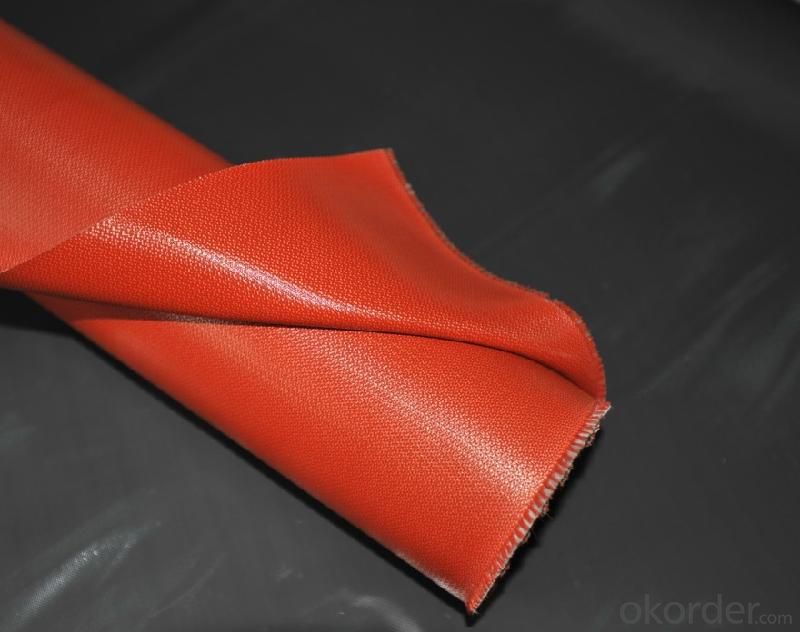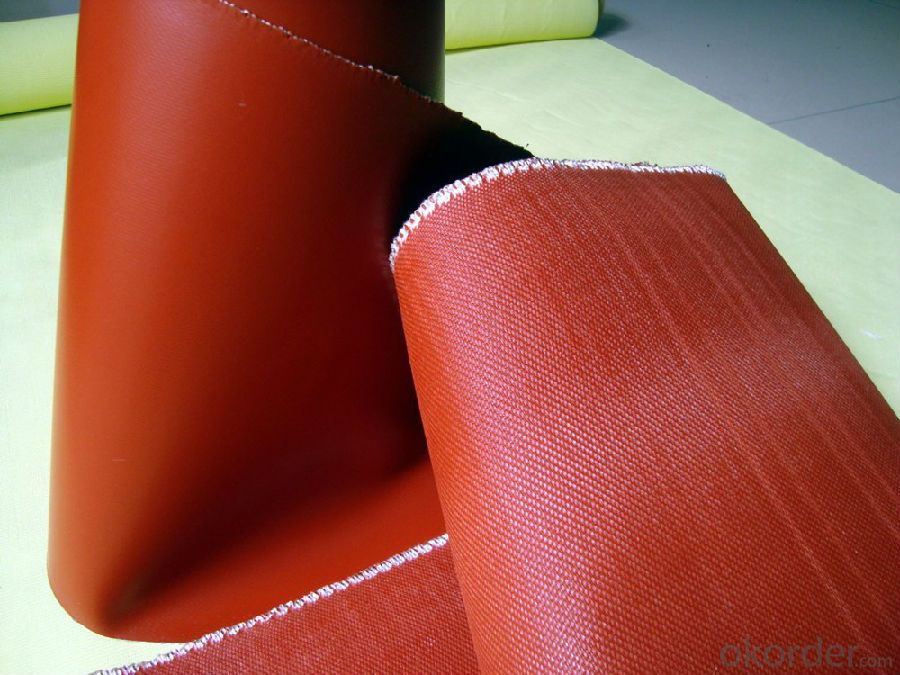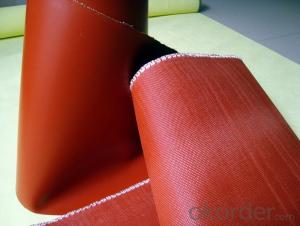Coated Fiberglass Fabric for Machinery Use
- Loading Port:
- Shanghai
- Payment Terms:
- TT OR LC
- Min Order Qty:
- 500 m²
- Supply Capability:
- 50000 m²/month
OKorder Service Pledge
OKorder Financial Service
You Might Also Like
Coated Fiberglass Fabric for Machinery Use
Fiberglass Fabric Description
Silicone coated fiberglass fabric is a fiberglass cloth, which possesses the properties of temperature resistance, anti-corrosion, high strength and is coated with organic silicone rubber.
Fiberglass Fabric Specification
Thickness:0.2mm-5mm
Width:100cm-150cm
Color;grey/red/silver/black
Weight(coating):130gsm-2800gsm
Model No | FSD2030 | FSD2030 | FSD2050 | FSD2100 | |
High temperature resistant(°C) | ≤280 | ≤280 | ≤280 | ≤280 | |
Low temperature resistant(°C) | ≥-40 | ≥-40 | ≥-40 | ≥-40 | |
Tensile intensity (N/50mm) | Warp | ≥1750 | ≥1750 | ≥2500 | ≥3500 |
Weft | ≥1280 | ≥1280 | ≥2100 | ≥3000 | |
Inflating burst intensity(Mpa) | ≥2.0 | ≥2.0 | ≥2.2 | ≥2.6 | |
Peeling intensity(N/m) | ≥450 | ≥450 | ≥520 | ≥600 | |
Insulation (kv/mm) | 16 | 16 | 18 | 18 | |
Weight (g/m*m) | 550-650 | 550-650 | 750-800 | 1500-1800 | |
Width(mm) | 1000±20 | 1000±20 | 1000±20 | 1000±20 | |
Thickness(mm) | 0.3-0.4 | 0.3-0.4 | 0.05-0.55 | 1.0-1.1 | |
color | Silver-gray, gray, red | lucency | Silver-gray, gray, red | Black, gray, red | |
Fiberglass Fabric Features:
1, Good performance on resisting high temperature and low temperature, -40°C-280°C;
2, High strength;
3, Ozone, oxide, light and weather aging resistance;
4, High insulation: dielectric constant:3-3.2, breakdown voltage: 20-50KV/MM;
5, Chemical corrosion resistant, oil-proofing, waterproofing (washable)
Fiberglass Fabric Application:
It has been widely used in construction, electric insulation,
chemical industry, pipeline ductile conjunction, large generating
Corrosion proofing field, machinery, metallurgy, sealing and so on.
Product Show


FAQ
1.What are the characteristics of fiberglass fabric?
a)Outstanding temperature resistance(from -70°C to +260°C)
b)Excellent chemical resistance
c)Superior non-stick surface, easy to clean
d)High dielectric strength
e)Dimensional stability
f)Resistance to UV, IR and HF
g)Non-toxic
2.How many methods to weave the fabric?
Four methods to weave the fabric:
a).Plain weave: it can be used in electricity insulation materials and reinforced materials in industry, because of inseparable structure, plain and clear lines.
b).Twill weave: compared with plain weave, it is of high density, high intensity, with a soft and loose structural weave. It can be used in ordinary reinforced materials, filter materials, and painting cloth.
c) Satin weave: compared with plain weave and twill weave, it is of high density,high intensity, with a soft and loose structural weave with a good texture. It is applicable for use as a higher reinforced material in machinery.
d).Gauze weave: said lattice twist weave. It can be used in spread model curtain,resin reinforced emery wheel gray cloth and lattice embed belt.
3.Can you offer us some samples?
We are willing to offer our customers best product&service,if it's necessary we can send
you sample for test;also we welcome all you customer have a trial order.
- Q:Can fiberglass fabric be used for insulation in food processing plants?
- Yes, fiberglass fabric can be used for insulation in food processing plants. It is a commonly used material due to its heat resistance, durability, and ability to provide thermal insulation. Additionally, fiberglass fabric is non-toxic, non-absorbent, and can withstand high temperatures, making it suitable for use in food processing environments.
- Q:Is fiberglass fabric resistant to chemicals and solvents?
- Yes, fiberglass fabric is generally resistant to chemicals and solvents. Due to its composition of woven glass fibers, it has a high resistance to a wide range of chemicals and solvents, including acids, alkalis, and organic solvents. This resistance makes fiberglass fabric a popular choice for various applications where exposure to chemicals and solvents is expected, such as in chemical processing plants, laboratories, and industrial settings. However, it is important to note that the level of resistance can vary depending on the specific type and quality of fiberglass fabric, so it is always recommended to consult with the manufacturer or supplier for specific chemical compatibility information.
- Q:What are the different dyeing options available for fiberglass fabric?
- There are several dyeing options available for fiberglass fabric, each with its own advantages and considerations. 1. Pigment dyeing: Pigment dyeing involves adding pigments to the fabric, which bond with the fibers to create color. This method offers a wide range of color options and is relatively easy to use. However, it may not achieve deep or uniform color penetration, and the color may fade over time due to exposure to sunlight and other environmental factors. 2. Solution dyeing: In solution dyeing, the color is added to the liquid before it is turned into fibers. This results in a more permanent and fade-resistant color as the dye is integrated throughout the entire fabric. However, it limits the color options available as the dye must be added during the manufacturing process. 3. Disperse dyeing: Disperse dyeing is commonly used for synthetic fibers like fiberglass. It involves dispersing the dye in a carrier liquid and then applying it to the fabric through various methods such as immersion, padding, or spraying. Disperse dyeing offers good color fastness and can achieve vibrant and uniform colors. However, it requires high temperatures and pressure to ensure proper dye penetration. 4. Sublimation dyeing: Sublimation dyeing is a heat transfer process where the dye is converted from a solid to a gas and then back to a solid on the fabric. This allows the dye to bond directly with the fibers, resulting in vibrant and long-lasting colors. Sublimation dyeing offers excellent color fastness and the ability to achieve intricate patterns and designs. However, it requires specialized equipment and is typically more suitable for large-scale production. It is important to note that the dyeing options available may vary depending on the specific type and composition of the fiberglass fabric. Additionally, the choice of dyeing method should consider factors such as the desired color, durability, and application requirements.
- Q:What material is that board on the computer main board? Is it harmful to your health?
- The main material of printed circuit board (PCB) is copper clad laminate, and copper clad laminate is made up of base plate, copper foil and adhesive. The base plate is an insulating plywood made of macromolecule synthetic resin and reinforcing materialThe main ingredients are: Copper resin reinforced material.To wear special masks, if not their own factory, can also buy a few. Not much money.
- Q:Is fiberglass fabric suitable for use in filtration systems?
- Fiberglass fabric is indeed appropriate for utilization in filtration systems. Renowned for its resistance to high temperatures, chemicals, and long-lasting nature, fiberglass proves to be an exceptional option for filtration systems demanding a material capable of enduring severe circumstances. Frequently employed in air filters, water filters, and industrial filtration applications, fiberglass fabric displays remarkable filtration efficiency as it proficiently captures and eliminates particles and impurities from fluids and gases. Moreover, fiberglass fabric can be tailored with ease to fulfill distinct filtration prerequisites, be it altering pore sizes or thicknesses. All in all, fiberglass fabric emerges as a dependable and efficient material for filtration systems.
- Q:What is the difference between non-woven fabrics, glass fiber cloth and geotextile?
- The exact name of the non-woven fabric shall be nonwoven or non-woven. Because it is a kind of form that does not require spinning weaving fabric, just a textile fiber or filament aligned or random, the formation of the fiber network structure, and then the mechanical, thermal or chemical methods and strengthening into. Nonwovens break through the traditional textile principle, and have the characteristics of short process flow, fast production, high yield, low cost, wide use and many sources of raw materials.
- Q:How do fiberglass fabrics perform in terms of moisture wicking?
- Fiberglass fabrics are not typically known for their moisture-wicking properties. They are better suited for applications where moisture resistance or insulation is required rather than actively wicking away moisture.
- Q:How does fiberglass fabric perform in terms of flexibility?
- Exceptional flexibility is a characteristic for which fiberglass fabric is well known. Its composition of fine glass fibers allows for easy molding and bending into various shapes and contours, all while maintaining its structural integrity. This quality of flexibility makes fiberglass fabric highly versatile, making it suitable for a wide range of applications. Industries such as automotive, aerospace, construction, and even fashion benefit from its adaptability. Moreover, fiberglass fabric's durability is demonstrated by its ability to withstand repeated bending and stretching without significant wear and tear. This durability makes it an ideal choice for projects that require long-term flexibility. In conclusion, fiberglass fabric offers designers and manufacturers the freedom to create innovative and dynamic products, thanks to its exceptional performance in terms of flexibility.
- Q:Can fiberglass fabric be used for making curtains and drapes?
- Certainly! Fiberglass fabric is a fantastic choice when it comes to crafting curtains and drapes. This remarkably versatile material boasts numerous benefits for this particular purpose. Not only is it lightweight and long-lasting, but it also exhibits exceptional resistance against heat, chemicals, and moisture. By utilizing fiberglass curtains and drapes, one can attain privacy while still allowing the gentle touch of natural light to permeate, thereby achieving an elegant and contemporary ambiance. Moreover, fiberglass fabric's effortless cleaning and maintenance make it an eminently practical option for curtains and drapes in diverse environments, be it residential dwellings, hotels, offices, or even medical facilities.
- Q:The pipe is too hot. What's the protection?
- Hot water pipes can be added to the outer wall insulation cotton protection.
1. Manufacturer Overview |
|
|---|---|
| Location | |
| Year Established | |
| Annual Output Value | |
| Main Markets | |
| Company Certifications | |
2. Manufacturer Certificates |
|
|---|---|
| a) Certification Name | |
| Range | |
| Reference | |
| Validity Period | |
3. Manufacturer Capability |
|
|---|---|
| a)Trade Capacity | |
| Nearest Port | |
| Export Percentage | |
| No.of Employees in Trade Department | |
| Language Spoken: | |
| b)Factory Information | |
| Factory Size: | |
| No. of Production Lines | |
| Contract Manufacturing | |
| Product Price Range | |
Send your message to us
Coated Fiberglass Fabric for Machinery Use
- Loading Port:
- Shanghai
- Payment Terms:
- TT OR LC
- Min Order Qty:
- 500 m²
- Supply Capability:
- 50000 m²/month
OKorder Service Pledge
OKorder Financial Service
Similar products
New products
Hot products
Related keywords



























